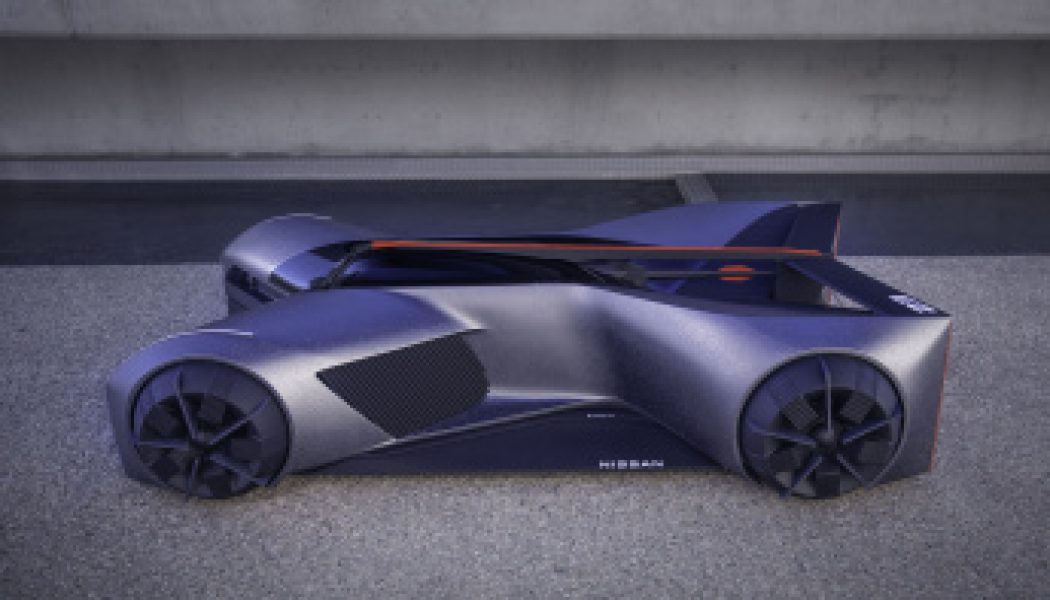The Nissan GT-R (X) 2050 concept is quite obviously a flight into the future. Designed by Nissan intern Jaebum (JB) Choi, it is an autonomous supercar designed for a single occupant who puts on a dockable body suit, climbs in, and lies face down and face first. This contortionist exercise is no mere sketch, either. David Woodhouse, vice president of Nissan Design America, was intrigued enough by Choi’s vision that he approved a full-scale model to be built.
Nissan GT-R (X) Concept: All About the Size and Shape
The concept is almost 10 feet long but is only about 2 feet high. It only has room for one person—who, technically, is not the driver since it is an autonomous vehicle. Would you ride in something like this, in that face-first, face-down position? We’ll leave that question in your head, but also point out that most autonomous vehicle concepts these days resemble shrunken subway cars with plain upright benches. So this is different.
Nissan’s concept also is essentially a wearable machine: the single occupant not only lies prone with arms and legs splayed so the body forms an X, but the “driver” (occupant?) wears a form-fitting suit and helmet—picture the skeleton competitors at the Winter Olympics.
Driver Wears a Dockable Suit
And the driver is essentially “docked” in the car: the helmet inserts into a slot to access the front vision camera with virtual-reality vision—there is a small window in the car but visibility is limited. Never mind that the occupant becomes a sort of iPhone charging cable in the process.
“Exo-skeletons today make people stronger by wearing mechanical structures,” says Choi. “I tried to fit the size of a person’s body as much as I could, as if I were wearing a car. I wanted to create a new form of machine that is not a vehicle to ride, it is the space where machine and the human become one.”
Woodhouse describes it as similar to a four-wheel superbike laid on its side.
The wheels are designed to allow the vehicle to turn 360 degrees. The tires have an outer diameter of 21 inches and inner wheel circle of 15 inches. An active wing adds downforce when extended—it folds so the drive can get in and out which is done by lifting the top of the car.
Powered Like Iron Man
The GT-R (X) supercar would be an electric vehicle and Choi visualizes a beating heart energy source, like the one in Marvel’s Iron Man. He envisions a lightweight vehicle made of a flexible material.
During a time of isolation and working from home, the X-shaped supercar evoked excitement, drew on some current Nissan GT-R design cues, and also dovetails with some of the future technology Nissan is working on, known as B2V for Brain-to-Vehicle, said Woodhouse in explaining why this project made it to the milling machine for a scale model.
The GT-R-inspired car would be an alternative for enthusiasts in a future of otherwise identical squarish pods providing transportation. As for the GT-R cues, Choi points to the taillights, red striped accents and overall body volumes.
“Brain-to-Vehicle” Technology
Woodhouse liked the idea of a supercar driven by brain-to-vehicle integration. “His (Choi’s) thesis was all about demonstrating the emotional connection technology can create, and the benefit that it can deliver for customers,” says Woodhouse.
Don’t get spooked, but a “brain-to-core transmitter” in the vehicle helps the brain activate the car. Choi’s idea was to connect the human brain to the car’s brain, the computer. The car design imitates the human body to protect the brain, he says.
In Choi’s vision, all cars decades from now are fully autonomous. In 2050 he envisions a world where computers have far better driving skills than humans and it may, in fact, be illegal for people to actually drive themselves. But they can feel as one with the car and give it directions and the car will determine if they are smart and safe to do.
Nissan used CES 2018 to show its emerging work on B2V technology that reads a driver’s brain waves. B2V interprets signals from the driver’s brain to assist with driving and to help the vehicle’s autonomous and manual systems learn from the driver. The technology promises shorter reaction times and systems that adapt to maximize driving pleasure.
Who is This Intern?
Choi, born in Seoul, South Korea, is a graduate of the ArtCenter College of Design in Pasadena, CA. His thesis was to create an autonomous GT-R for 2050, when machines are a physical extension of the driver.
As part of his internship at Nissan Design America, (mostly a remote exercise, done from home because of the pandemic) Choi brought his thesis to life as the Nissan GT-R (X) 2050 concept. He never imagined Nissan would let him create a full-size model.
Choi’s internship has ended, but he will soon be a Nissan employee, Woodhouse says.










